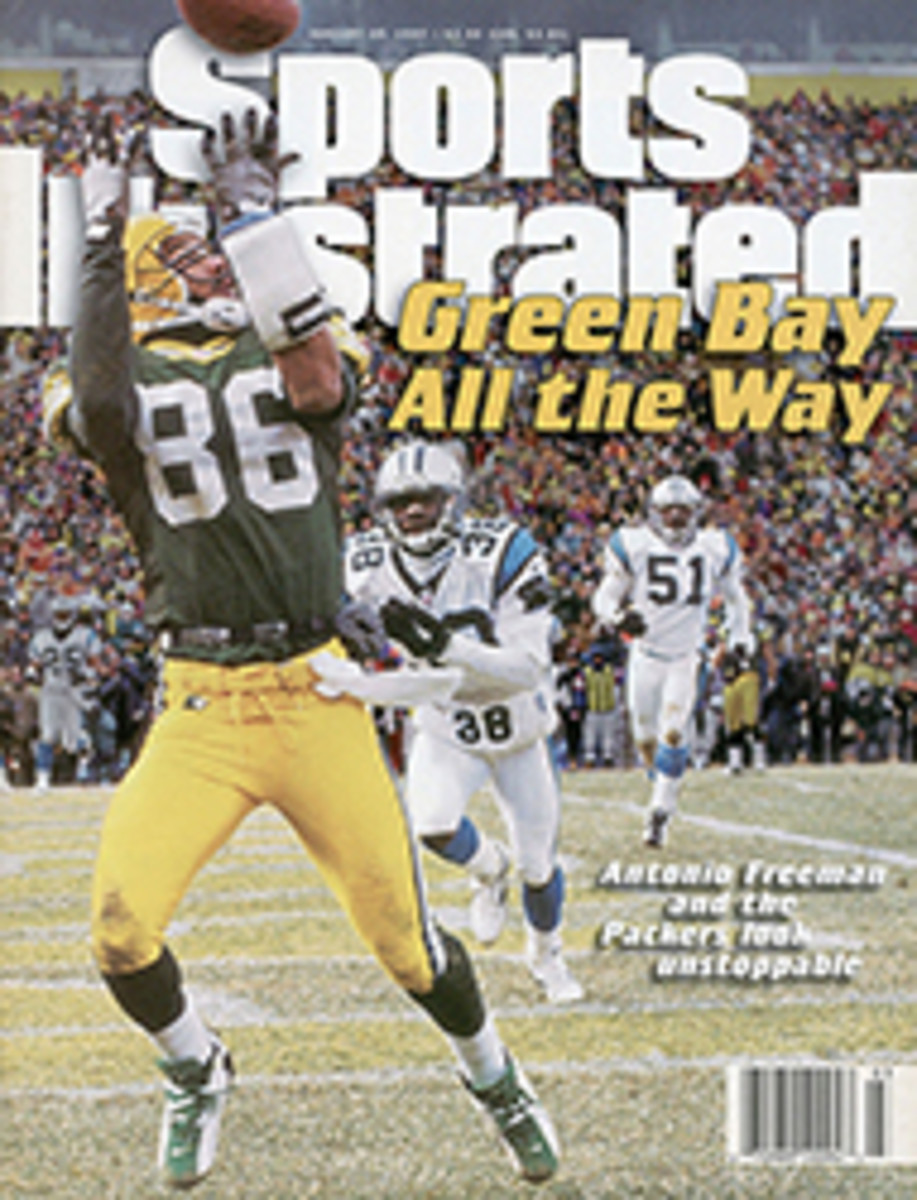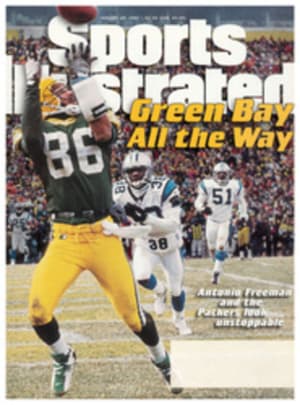
AN ANIMAL INTENSITY CAVALIERS GUARD BOBBY PHILLS IS THAT RAREST OF BREEDS: A DEMON ON D WHO CAN ALSO NAIL THE THREE
Only a few players can consistently stymie the NBA's most potent
scorers at one end of the floor and bury the three-pointer at
the other. Only one of them can do both and has castrated a pig,
reached inside a pregnant cow to examine a calf and had his car
taken away by his parents because his college grade point
average dipped below 3.0.
That player would be 27-year-old Bobby Phills, the 2-guard for
the Cavaliers, and the one guard in the league who holds a
degree in animal science and aspired to be a vet. On defense
Phills is, well, a pit bull, a 6'5", 220-pound warrior with 4.8%
body fat. He's too quick to blow past, and he's too burly to be
posted up. "He's as tough as there is," says Bullets guard
Calbert Cheaney. "The only way to beat him is to outthink him,
but he really studies opposing players, so it's hard to beat him
that way, too."
On offense Phills has a marvelous shooting touch--rare for
anyone so muscular. At week's end he was averaging 12.6 points
for maniacally D-minded Cleveland and was shooting a splendid
39.2% from beyond the three-point arc. Finally, his talents have
been recognized: After five seasons he's on the All-Star ballot
for the first time. "That's big," he says. "Someday I will be an
All-Star."
If relentless one-on-one defense were a more valued criterion
(which it should be this season, when only a handful of teams
average more than 100 points), Phills would be on the '97
Eastern Conference roster. Has any guard ever abused him on the
low block? "No," Phills says. Has any guard ever regularly
beaten him off the dribble? "No," Phills says.
Last season the NBA's coaches named Phills to the All-Defensive
second team, behind Chicago's Michael Jordan and Seattle's Gary
Payton. Rarely has anyone done a better job on Jordan than
Phills did on April 9, 1995, three weeks after the Greatest
Player Ever came out of retirement. Phills hounded Jordan into
9-for-26 shooting and 21 points. (Phills had 19.) "I saw that
game against Jordan a couple years ago," says Charlotte forward
Anthony Mason. "He did a hell of a job on Michael. Guys make the
All-Defensive first team because of their offense. They just put
those guys on. Phills has got the rare combination of speed and
strength. He'll get there one day."
Phills hasn't always stopped Jordan, who scorched him for 45
points last Dec. 28 in Chicago. Still, His Airness has praised
Phills's defense. So has Indiana guard Reggie Miller, whom
Phills has muffled more than once. "I've done well against
Reggie," Phills says. "He's so thin, I try to beat him up--not
to hurt him; I lay on him, post him up on offense and try to
tire him out so he's not as energized on offense."
When Phills competes in the 12th annual Three-Point Shootout at
the All-Star Game in Cleveland, he'll become the sixth player in
NBA history to make an All-Defensive team and participate in
that event. (From that group Jordan and former Laker Michael
Cooper are the only players to have made first-team
all-defense.) Phills became a dangerous deep threat thanks
partly to Denny Price, the father of NBA sharpshooters Mark and
Brent Price. Denny, the women's basketball coach at Phillips
University in Enid, Okla., is an accomplished shot doctor, and
Phills paid him a one-week visit in each of the last two
summers, launching jumpers for 90-minute stretches twice a day.
Phills's painstaking practice has paid off. A righthanded
shooter, he had been releasing the ball from the left side of
his head; Price moved his release to the proper side. After
making one three (in 12 tries) in 1993-94, Phills made 19 (34.5%
shooting) in '94-95, then 93 last year (44.1%). Through Sunday
he had nailed 47 this season. "We taught him too well," says
Denny, laughing. "Back in December, he made two big threes
against Golden State and beat my son Mark's team. Bobby is
always working to improve his game. He has a great work ethic."
Phills didn't merely hone his shot in the summertime. During the
past two off-seasons he ran an Educational Awareness Basketball
Training Camp for 12- to 18-year-olds in his hometown of Baton
Rouge. Each camper must have a 2.0 grade point average and write
an essay in order to participate. "With the money we make in the
NBA, there's so much of an emphasis today for kids to be pro
athletes," Phills says. "We've got to reroute their minds so if
they don't make it, they have something they can live on."
His parents certainly stressed hard work and hitting the books.
Phills's mother, Mary, is a mail sorter for the post office; his
father, Bobby Sr., the dean of agriculture and home economics at
Southern University in Baton Rouge, where Phills was a four-year
star. "Make a 3.0 every semester," Bobby Sr. told his son in
high school, "or you don't play ball." Bobby Jr. never ran afoul
of that edict at Southern University Lab High, but he once did
so at Southern, and though Bobby Sr. didn't keep him off the
team, he did take away his car for a semester.
Phills started out in college as a premed student, but he took
an animal-science course as a sophomore, was "fascinated" by it
and switched majors. "I didn't grow up on a farm or anything,"
he says. "We just had a dog." At Southern he worked with farm
animals, and Phills says he one day might buy a horse-and-cattle
ranch. At this point he's not planning to go back to school for
the four years required to become a vet. "I'd like to play seven
or eight more years," he says. "Then I might own a veterinary
clinic."
When he graduated from Southern, such a long and lucrative
career seemed unlikely for Phills. He was drafted 45th by
Milwaukee in 1991 and then waived in mid-December. Phills toiled
most of that season in the CBA until Cleveland signed him to a
10-day contract in March. He stuck with the Cavaliers in 1992-93
but was used sparingly, and when new coach Mike Fratello opened
preseason camp for '93-94, Phills had to squeeze onto a roster
fat with guaranteed contracts.
"I loved everything about Bobby," Fratello says. "I knew he
could play in the league. But I didn't know if I could keep him."
Right before the season began, guard Terrell Brandon came down
with mononucleosis and forward Larry Nance injured his knee,
ensuring a spot on the team for Phills. With Cleveland 7-14,
Fratello inserted Phills into the lineup, first at small forward
and then at shooting guard. He has remained there ever since.
The Cavaliers went 40-21 the rest of 1993-94, and they are
151-108 since Phills became a starter.
"When those guys got hurt," Phills says, "Coach looked down the
bench, and only I was left. But I never doubted myself. I knew
in the right situation I'd stick." After all, sticking--whether
an open three-pointer or on an opposing guard--is what Phills
does best.
TWO COLOR PHOTOS: DAVID LIAM KYLE Phills, who has developed a feathery shooting touch, has always made his presence felt on defense. [Bobby Phills in game against Atlanta Hawks; Bobby Phills in game against Denver Nuggets]
COLOR PHOTO: CARL SISSAC [Mookie Blaylock in game]
TIP-OFFS
FOR THE WEEK OF JANUARY 6-12
THE MOVE
For the second time in two weeks, Phoenix made a bold deal,
acquiring enigmatic 6'7" forward Cedric Ceballos from the Lakers
for 6'10" Robert Horry. If the Suns can keep Ceballos from going
AWOL--remember last year's midseason waterskiing trip?--he will
be a nice complement to their new point guard, Jason Kidd.
THE STAT
The Bulls were 31-4 at week's end, just one game behind their
pace of '95-96, when they set a record with 72 wins. Their
average margin of victory, 13.2 points, is higher than last
season's mark of 12.3.
THE QUESTION
Will the chronically sore feet of 7'4" Pacers center Rik Smits
ever heal? Since returning to the lineup on Jan. 7 after
undergoing surgery for compressed nerves, he has averaged 12.7
points in 24.0 minutes. But he still puts on shoes before he
gets out of bed because walking in bare feet is too painful.
Indiana needs a healthy Smits to challenge in the East.
POINTS OF DEPARTURE
Whatever happened to the playmaker who directed the offense
rather than carried it by himself? At week's end nine point
guards were their teams' top scorers. Ten years ago only two
point guards shouldered that much of a team's scoring load.
Ditto for the 1976-77 season.
"The position has changed," says Lakers general manager Jerry
West. "The point guard used to be the little guy who got you
into your offense and played good defense. Now they're much more
offensive-minded." And much more offensively gifted. "They don't
need to pass," says Orlando G.M. John Gabriel, "because they'd
be making the pass to themselves."
But a coach who relies on a little man to take a huge number of
shots has history against him. The three point guards who have
won scoring titles--Dave Bing (1967-68 Pistons), Tiny Archibald
(1972-73 Kings) and Pete Maravich (1976-77 Jazz)--all played for
teams with losing records. And only three NBA champions had a
playmaker as their leading scorer: Isiah Thomas's Pistons in
1989-90, Magic Johnson's Lakers in 1986-87 and Gus Williams's
SuperSonics in 1978-79. "I don't know how many teams can win it
all with a point guard who is taking the most shots," says
Denver's Mark Jackson, the league's assist leader. "That's no
knock on the guys who do. They're a nightmare to guard. But it
takes a lot of other guys out of the game."
Still, many believe that the way the game has evolved, point
guards have to be point happy. "Now everyone doubles the post,"
West says, "so those most clever with the ball get the shots."
Phoenix's top scorer, 6'1" Kevin Johnson, notes that "with so
much one-on-one and pick-and-roll, and no hand checking and the
closer three-point line, the smaller guards really benefit." And
Clippers coach Bill Fitch points to the deterioration in ball
handling skills among frontcourt players. "The fewer movable
parts in the machinery, the less chance of error," he says. "Put
the ball in the best hands." --T.K.
SHOT TAKERS, NOT PLAYMAKERS
By choosing to pass first (407 assists) and shoot second (279
field goal attempts), the Nuggets' Mark Jackson has the lowest
shot-to-dish ratio (0.69) among starting point guards this
season. Here, at the other end of the spectrum, are the league's
most trigger-happy playmakers.
POINT GUARD FGA ASSISTS RATIO
Allen Iverson, 76ers 547 198 2.76
Mookie Blaylock, Hawks (above) 425 155 2.74
Terrell Brandon, Cavaliers 594 230 2.58
Gary Payton, Sonics 677 269 2.52
Damon Stoudamire, Raptors 616 260 2.37
THE QUOTE
"He's especially tough when [the refs] let him carry the ball,
double dribble the ball and do anything he wants with the ball."
--Magic coach Brian Hill, on Raptors point guard Damon Stoudamire

